Introduction
Packing for an Iceland road trip isn’t like packing for your average weekend getaway. It’s more like preparing to survive all four seasons in a day, while living out of a van that also functions as your kitchen, lounge, bedroom, and occasionally your drying rack.
Let me rephrase that – this isn’t a slow weekend abroad, it’s an adventure, and adventures often need more consideration when packing.
This guide will help you pack smart, not heavy. Whether you’re chasing the midnight sun, braving winter winds, or just trying to find your socks in a tiny cupboard, this is everything you need to know before loading up your Happy Camper.
Why Packing Smart for Iceland Matters
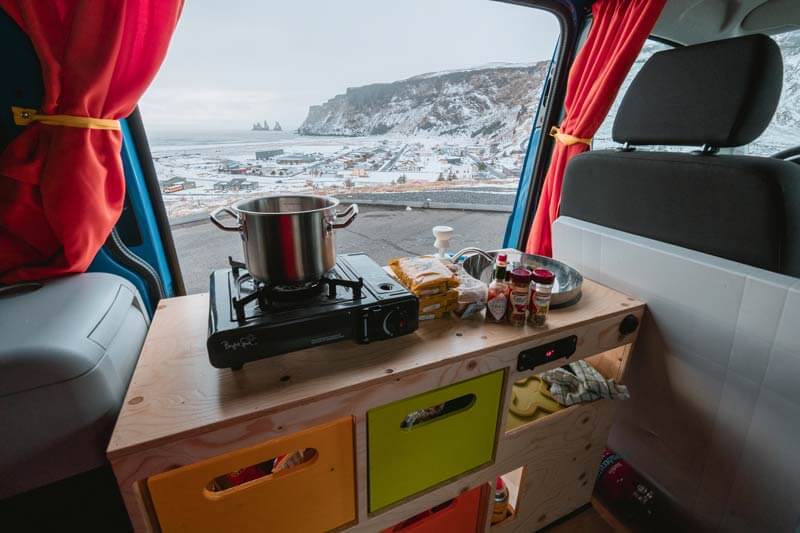
In Iceland, the weather doesn’t follow the rules. It might be sunny and warm one minute, and then hit you with sideways rain and a wind that wants to steal your lunch the next.
Packing smart means being prepared for anything without stuffing your campervan to the roof. Because when you’re cooking on the backseat or trying to find your head torch in the dark, space matters – if your partner or family have a chaotic member who regularly cast their clothes all of the place, I’ll need to write a separate guide!
And since Iceland rewards the adventurous, the prepared, and the weatherproof, packing the right gear can make or break your trip.
Packing for an Iceland Road Trip in a Campervan
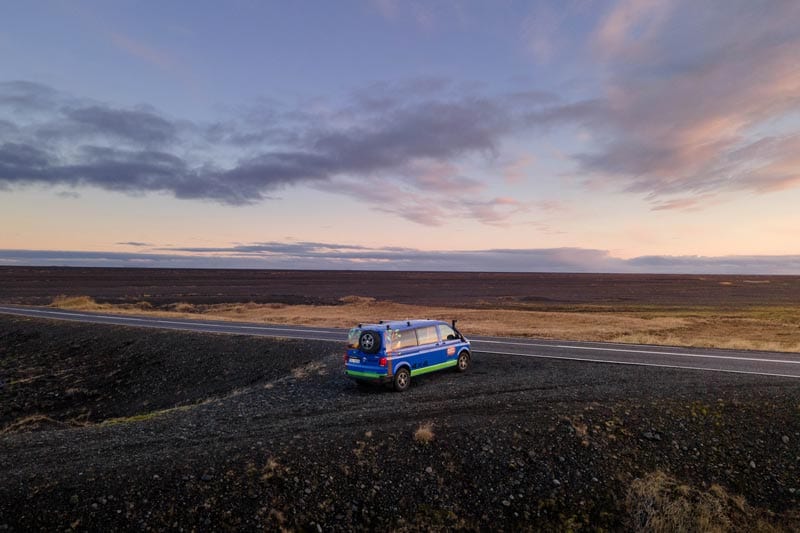
The Difference Between a Campervan Trip and a Hotel Stay
You won’t have a reception. Or a wardrobe. Or a towel on your bed folded into the shape of a smug looking swan (I’ll be honest, I don’t think any hotels in Iceland have this either). There is no room service unless you’re serving yourself, and your minibar is whatever snacks you remembered to stash before leaving Reykjavík.
A campervan is your mobile base camp, your movable temporary home on wheels. Your wardrobe? A cleverly stuffed backpack or duffel bag crammed into our celver storage sections. Your kitchen? A gas stove and pans set that provides a more rustic breakfast and dinner skillet skillet, pasta pot, and boiling kettle all in one.
Your bed is your bed, yes, but it might also double as a drying rack for your damp socks, a comfy reading nook, or a makeshift office when you need to stay connected or edit and upload your latest video or picture.
Everything needs to be functional, compact, and ideally free of smells that make you question life choices. Think multi-purpose, stackable, and soft-sided. Embrace the organised chaos and you’ll find campervan living is not only manageable, it’s kind of brilliant.
Vanlife has been around for decades, and it’s convenience and comfort can make a natural wonderland like Iceland into the ultimate adventure. You can cook under the Northern Lights, watch a movie on you laptop next to a glacier, or simply enjoy the fats paced and rugged lifestyle you’ve opened your holiday up to. You can even select which kind of camper best suits the kind of trip you’re after (yes, a bit of a self plug I know!)
What’s Typically Included in Your Campervan Rental
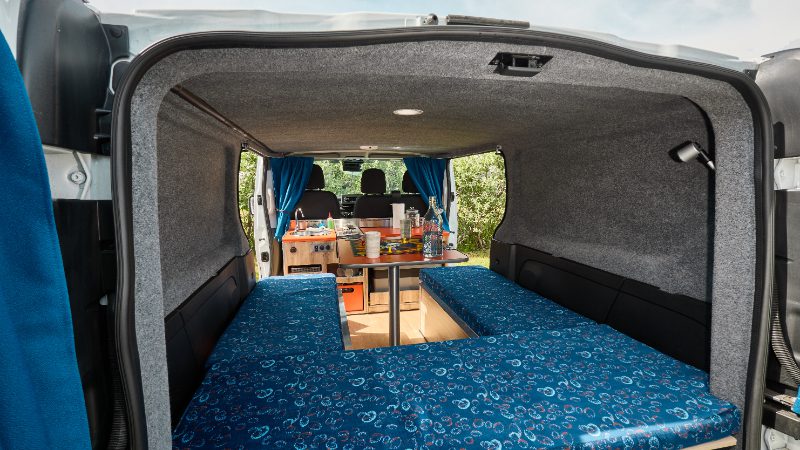
When you rent a campervan from Happy Campers, you get the basics covered with some clever additions from our teams well-thought designs. Expect a comfy bed, cosy bedding, a gas stove for whipping up your campfire cuisine, a pot and pan duo that’s about to become your best mates, cutlery, a fridge or cooler to keep your Skyr chilled, interior heating for those brisk Icelandic nights, and cleaning gear to keep the place from descending into snack-fuelled chaos.
Our campervans also come with WiFi to keep you connected (10 EUR per day for EX campervans), as well as a series of optional extras: foldable tables and chairs for al fresco dining with mountain views, and 4×4 capabilities for travellers planning to hit the Highlands or remote corners of the country.
But even with all that, there are still a few gaps. Towels, cooking spices, dish soap, your phone charger, and anything you need to feel like a functional human in the morning (ahem, six cups of coffee) aren’t typically included. That’s where this list comes in handy to help you pack the little things that make a big difference (we also won’t pack your clothes!)
How to Maximise Limited Space: Packing Tips for Small Spaces
Think small, soft, and stackable. Packing cubes are your vanlife MVPs. Use them to sort clothes by day, activity, or function. Always plan around warm layers for those wind-whipping pit stops, hiking gear for muddy adventures, and pyjamas you can actually locate in a hurry. Don’t worry, I’m making it sound a little intense, but you can not be a German citizen and still organise your gear well (efficiently).
A collapsible laundry bag can be a game-changer depending on your plans. It keeps the chaos contained and makes it easier to use a laundry facilities which can be found at many Iceland campgrounds. Use carabiners or suction hooks to hang mesh bags and free up space. This is ideal for airing out socks or keeping snacks off the floor. Bonus points if you label things like a Type A legend.
Ok, by this point you’re probably on the spectrum, but you get the point.
Always favour items that serve multiple purposes where possible: a scarf that turns into a picnic blanket, a hoodie that works as a pillow, a flask that becomes your icebreaker at camp (even if it’s the horrible Bónus one with a pig by a waterfall I have just discovered in my kitchen).
If it doesn’t serve multiple functions or bring you daily joy, leave it at home. You’ll thank yourself the first time you find your headlamp on the first try.
Essential Iceland Campervan Packing List
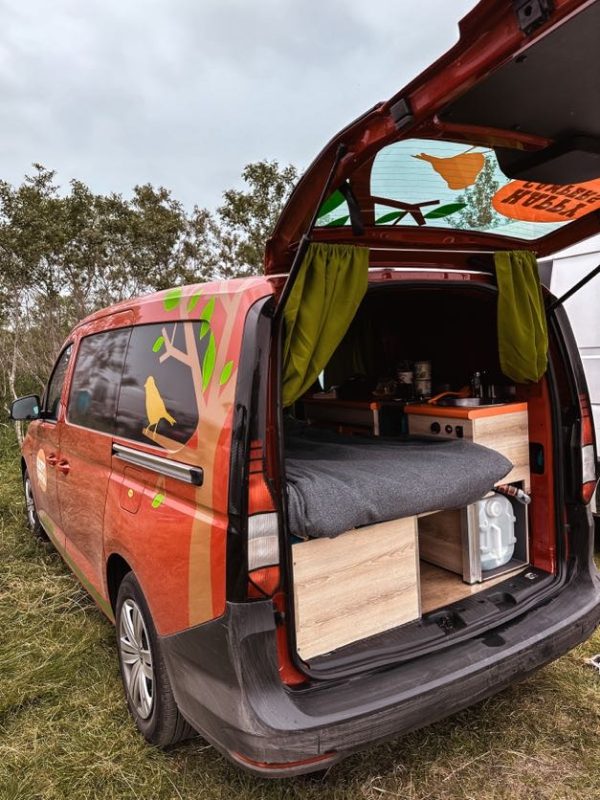
Clothing to Pack For Iceland
You need layers. Loads of them. The kind you can peel off in a lay-by at lunchtime and pile back on once the next weather front rolls in 20 minutes later.
Start with base layers preferably made of thermal or merino wool, especially if you plan on hiking or spending any time standing still admiring waterfalls in the wind. Add a few warm mid-layers like one or two fleeces or thick jumpers that can double as evening gear.
A waterproof jacket with a hood is essential. Look for breathable fabric and sealed seams to avoid becoming your own personal sauna. Windproof outer shells can be lifesavers on those days when it feels like Iceland is trying to throw you off a cliff.
Pack a proper woolly hat that covers your ears, gloves that work with touchscreens (let’s be honest, we all pull out the phone more often than we’d like to admit), and thick socks that won’t slide off inside your walking boots every ten minutes.
Jeans? They’re fashionably hopeless when wet. Stick with quick-dry hiking trousers or thermal leggings layered under shell pants. Waterproof walking boots with ankle support and good tread will have you safely navigating some of the rocky terrains while others are sheepishly slipping on wet stones.
Even in summer, don’t skip the wool jumper. Icelandic evenings get brisk. And yes, even in the middle of winter, sunglasses can save your retinas from the glare off snow and ice. The sun’s UV is also stronger at higher altitudes, and if you’re out trekking in the sun you don’t want the embarrassment of getting sun burnt near the Arctic Circle.
Iceland Campervan Living Essentials
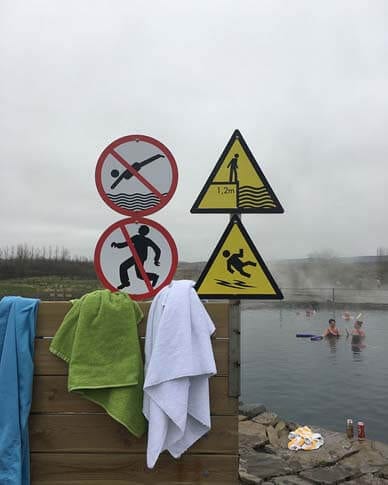
A quick-dry towel for fast turnaround after hot spring dips and campsite showers goes without saying, unless you enjoy air-drying each day.
A headlamp for hands-free lighting during midnight van reorganisations or late-night toilet runs, as well as for any late night photography is a great help.
Microfibre cloths are a must for battling that sneaky overnight condensation on the van windows, especially when you wake up wondering if you accidentally slept in a cloud or spend an hour working out who breathes the deepest.
A reusable water bottle keeps you hydrated without constantly buying plastic bottles (plus Iceland’s tap water is as pure as it gets – as a foreign man who lives here, I get the joy of hearing the locals say this several times a week!)
In my opinion, earplugs are also essential if your travel buddy snores like a Viking after too much beer post-great victory or if you’re parked near a spirited campsite kitchen.
Consider a travel pillow if your neck demands a little extra love at night. Flip flops are also ideal for hopping into communal showers without catching a mystery foot souvenir. And a cosy hoodie or oversized jumper becomes your best mate when the wind picks up – it’s perfect for lounging, layering, or even folding up as a makeshift pillow.
Bring a backpack or lightweight stuff sack to throw in your camera, snacks, and layers when heading off for short hikes or spontaneous grocery runs. If you have a tote bag for shopping as well then you’re ticking all bases.
Cooking & Eating Gear
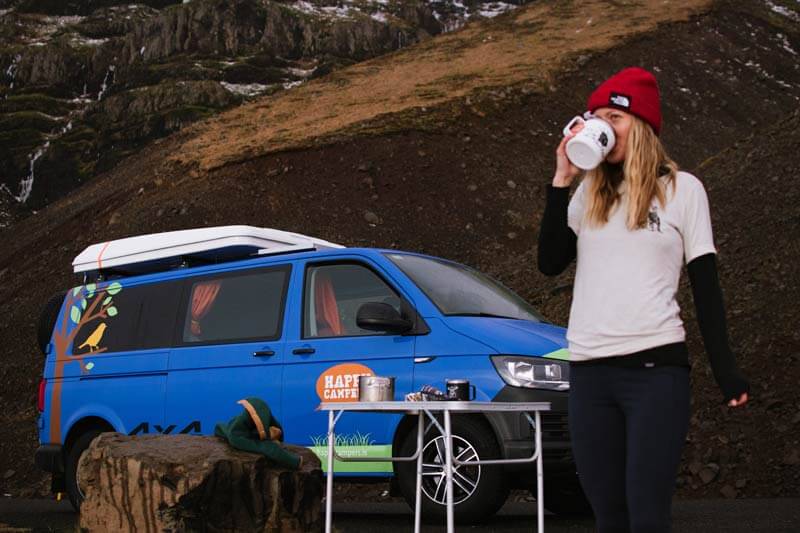
You’ll get the basics, but if you enjoy cooking beyond boiling pasta, there are a few extras you’ll want to bring. A small stash of seasoning, cooking oil, your favourite tea bags, and good coffee go a long way in turning a simple camp dinner into something that actually tastes like a meal. You can find all of these items at local supermarkets around the country – Bónus and Krónan are often the cheapest options.
Bring a reusable coffee mug and a decent thermos if you have space. They’ll become your best friends during early morning drives or while watching the sun set behind the mountain tops. Our vans are also equipped with cupholders – if you’re a millennial or older like myself, you can appreciate this small luxury!
A collapsible washing-up tub or basin can sometimes be worth it, but often you will find these available for usage at the campgrounds. It makes cleaning up outside easier and stops you from turning your camper’s sink into a dish-pocalypse (I’d add a picture here, but…maybe not).
If you’re after more tricks and inspiration, check out our guide to the best meals to cook in a campervan and see how to make magic with one burner and a wooden spoon.
Electronics & Tech Gear
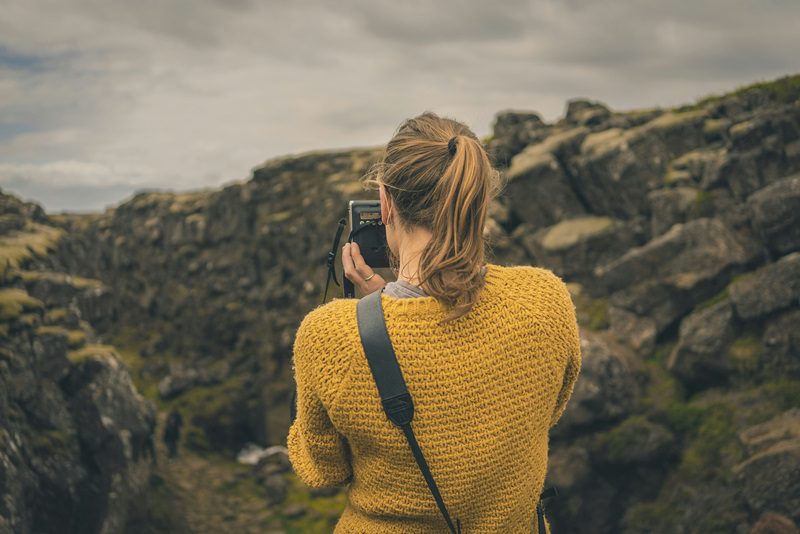
Phone, camera, charging cables, and a reliable power bank should be top your tech list (or ‘the IT’ as my mother calls it). These are the essentials that keep your navigation, memories, and occasional Netflix downloads running smoothly.
Optional extras include a laptop for editing photos or remote work, an e-reader or kindle to save space on books, and a drone if you’re planning to get those jaw-dropping aerial shots. However, make sure you’ve read up on Iceland’s drone regulations before you take off and respect the signs at various attractions around the country.
Most campervans let you charge devices while on the move using built-in inverters or cigarette lighter adapters. If you’re bringing a lot of gear, consider packing a multi-port USB charger or an inverter that works with your van’s outlets for charging cameras, laptops, or drones overnight – I’d be careful on this to ensure you don’t drain the battery and make an awkward call to our office the next morning.
When in doubt get in touch with our team for advice.
Not that you’ll be packing these, but offline maps can be really handy in Iceland, where signal can drop faster than a cliffside waterfall in some of the more remote places.
Use apps like Maps.me or download areas on Google Maps before heading into the Highlands or Westfjords. I’d highly recommend using our teams campsite map which displays all the information needed and various links about all of Iceland’s campgrounds.
Toiletries & Health
Toiletries basics should include a toothbrush, toothpaste, shampoo, conditioner, deodorant, and body wash – keep it travel-sized where possible to save space.
Add sunscreen (even cloudy days can roast you here), lip balm with SPF, hand sanitiser, moisturiser (because Icelandic wind and hot springs will try to turn you into a raisin), and travel tissues for those moments when the sniffles hit, or after you’ve just watched the end of a Pixar film.
Motion sickness pills are smart if you’re driving round the winding fjord roads and suffer from travel sickness, or if you’re planning on joining a whale watching tours, or just have my dad in the frontseat who still drives like he’s trying to beat Lewis Hamilton.
Don’t forget any prescription medication in its original packaging, plus a backup supply in case of travel delays. Bring painkillers for post-hike knees, antihistamines for the odd sting or sniffle, and plasters or blister pads for when your shoes decide to bite back. A small bottle of antiseptic and a mini first aid kit wouldn’t hurt either (just sting a bit).
Emergency & Safety Items

Most of the following items I would not consider essential, but if you are worried about some of the possible less safe things that could happen in Iceland, then these can keep you safe.
Consider a mini first aid kit with plasters, antiseptic wipes, and basic pain relief. Bring a whistle in case you need to alert someone across a windy fjord. A reflective vest if you’re walking roadsides at dusk or near traffic, can be especially helpful during shorter daylight hours when airing on the side of caution.
A small torch or headlamp for late-night toilet trips, emergency tyre checks, or searching under your bed for that one lost glove. Bring spare batteries too if you have the space.
Thick sellotape or duck tape is the unsung hero of the campervan world. It fixes broken gear, reseals containers, patches a tear in your jacket, or holds together a cracked shoe sole until you reach civilisation.
A printed list of emergency numbers, campsite contact details, and your campervan rental info is a smart backup if your phone dies or decides to ghost you in the Highlands. You can also use this for old school travel journaling, channeling your inner Walter Mitty.
Road Safety

A paper map is a wise backup for those analogue emergencies, especially if you’re heading into the Highlands where tech tantrums are more likely from time to time.
And if you haven’t already, make sure you read through our guide to driving in Iceland. Iceland’s roads can be a little wild, a little icy, and sometimes more lunar than logical, especially in winter or on those sneaky Highland F-roads.
Don’t over-stress it too much, Iceland is a small country and has much fewer roads and route options than you are probably used to, so getting lost is unlikely. Also, aside from the Highland F-Roads, the main roads you’ll drive on are regularly well-maintained across the seasons.
Seasonal Packing Tips

Summer (June to September)
Expect mild temperatures that still somehow manage to chill your bones at times, incredibly long daylight hours that mess with your body clock (and my cats) in the most delightful way, and the occasional sneak-attack storm that shows up just as you’re about to fry up some eggs outdoors.
That means layers are still your friend (even in July) and waterproofs shouldn’t be left behind just because the forecast looks vaguely friendly. As the expression goes in Iceland and many other places in the far North, if you don’t like the weather, just wait 10 minutes.
An eye mask is a must unless you enjoy trying to sleep under what feels like an overhead sunlamp. And if you’re heading to Lake Mývatn, prepare for bugs that assume they’re bunking with you. Bring some bug spray to use as a Nuclear detterrent for these pests.
A sun hat or cap keeps you from frying your scalp while hiking volcanic trails, and camp sandals are worth packing for the quick dips and campsite washes.
Winter (November to March)
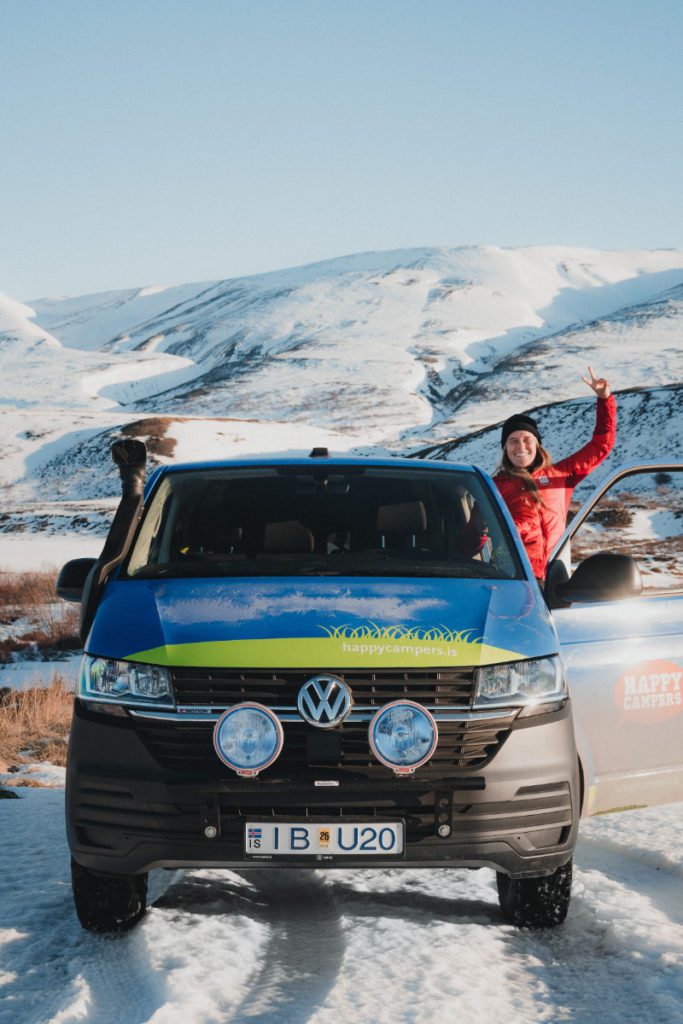
You need to layer like an onion as Shrek says and insulate like an igloo (as Donkey says? Nope, maybe not). Be a strategic survivalist like Bear Grylls, and maybe think slightly ridiculous, because when the wind hits you sideways while you’re brushing your teeth outside your campervan, you’ll be glad you did.
Pack thermal everything. That includes base layers, leggings, shirts, and even underwear if you’re serious about staying warm. Thicker socks (preferably wool), insulated winter boots with solid grip, and crampons or microspikes for icy trails will turn those sketchy paths into walkable wonders. You can often gramp some cheap crampons in places like Hagkaup or gas stations in the various towns around the country.
Hand warmers can be a good shout during sunrise photo stops and midnight nature calls. A proper head torch with extra batteries goes without saying as mentioned above.
Consider adding a pair of ski gloves, and a windproof balaclava to your winter arsenal. They might seem excessive at first, but they become non-negotiables once temperatures dip and you’re trying to sleep with your nose peeking out of your sleeping bag.
Read our Iceland winter camping guide for more cold-weather magic and everything else you didn’t know you’d need.

Cards or games for rainy nights. But beware, Uno can get weirdly intense at 2am in a campervan while the rain pelts the roof like it’s auditioning for a dramatic Icelandic soundtrack.
A foldable stool can be a back-saving marvel when you’re cooking outside or need a perch for staring wistfully at mountains (you can add this as an extra).
Consider a travel journal for recording misadventures, weather-induced wardrobe changes, or the philosophical thoughts that only come while parked under the Northern Lights. A Polaroid camera is a nostalgic touch for those who like tangible memories and have some space on the fridge at home.
And yes, Icelandic liquorice counts as an essential (I can’t stand it, but you should try it). Even if you hate it, you’ll still end up eating some, wondering why it tastes like salty ambition and mild regret.
Packing Strategies & Pro Tips
Roll Your Clothes & Use Packing Cubes
More space. Less chaos. Rolling reduces wrinkles too. It also helps you see exactly what you’ve packed at a glance, making those early-morning outfit decisions slightly less chaotic when you’re half-asleep and hunting for that one pair of socks you swear you brought.
Plan Outfits by Day & Activity
Avoid the 6am scramble in the dark. Lay out your next day’s outfit before bed (socks, base layers, weather-proof jacket, the whole works) so you can slide into it faster than the wind can change direction.
It saves precious minutes in the morning and reduces the risk of accidentally wearing your jumper as trousers in the dark. You’ll thank yourself later, especially when the van’s still cold and you’re half-dressed trying to find your glove that’s hiding under yesterday’s crisp packets.
Re-wear Base Layers When Possible
Merino wool is magic. It doesn’t smell, dries quickly, and feels soft enough to make you question every synthetic base layer you’ve ever owned. It regulates body temperature like a tiny personal thermostat, keeping you warm when it’s cold and cool when it’s warm.
You can also wear it for days, making it ideal for multi-day road trips where laundry is more of a luxury than a routine.
Store Dirty Laundry Separately
Keep your van smelling vaguely like a home instead of a gents football changing room (or my neighbours storage). Use a sealable laundry bag or dry sack to keep the smell of used socks and muddy trousers contained.
Throw in a dryer sheet or a small sachet of lavender if you’re a total pro (or at least want your hoodie to smell less like adventure and more like something you’d actually wear indoors).
If you’re heading off for more than a few days, plan to do a laundry stopat a campsite mid-way to keep things fresh and save your nose from the scented punishment.
What You Can Buy or Rent Locally in Iceland
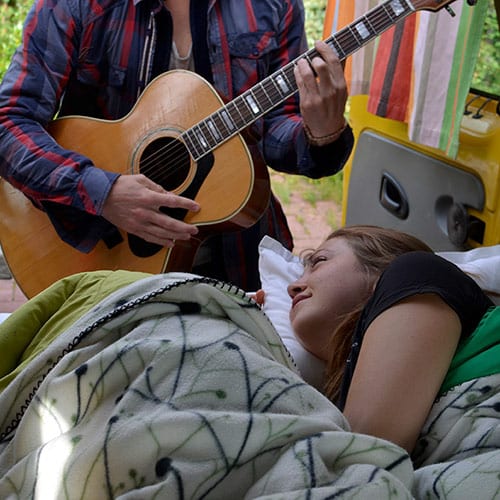
Don’t forget you can rent extras from us, like foldable chairs, BBQ grills, caffetiere’s, and inverters. These can add a lot of comfort and value to your experience when you’re far from civilisation and just want a hot burger or some quality coffee by a waterfall.
You can also stock up on groceries, toiletries, or missing basics at supermarkets like Bónus, Krónan, or Nettó. They’re found in most larger towns and even some smaller villages, and they’re often your cheapest bet for essentials.
Need outdoor gear? Check camping and outdoor stores in Reykjavík or Akureyri. Our add-ons should cover most of your requirements, but if you find you’re missing something out on the road, we’d recommend a quick pit stop at a local JYSK.
The Challenges of Iceland’s Weather & Road Trip Conditions
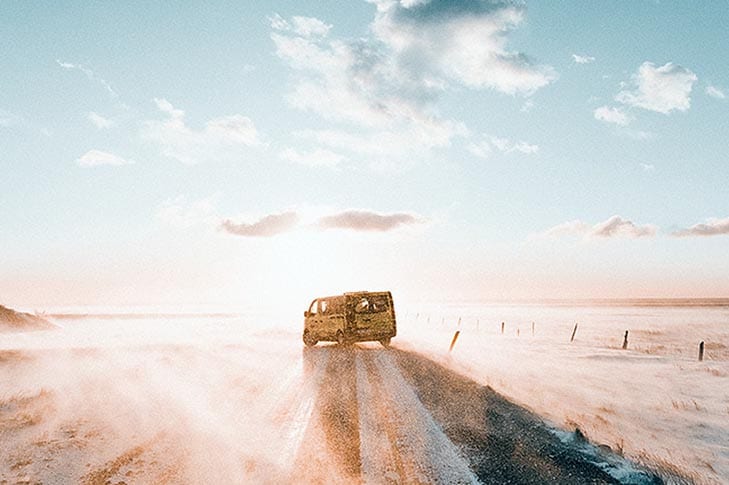
Rain, wind, fog, sleet, sunshine, repeat. Sometimes all within half an hour.
Roads can be bumpy, gravel can surprise you, and some showers are more of a polite mist than a warm hug. Campsites range from comprehensive geothermal gems to basic patches of land with a spectacular view.
But what you gain far outweighs the rustic quirks. After all, you’re exploring steaming volcanic landscapes that look like they’ve been photoshopped, hidden hot springs that can feel like your own private spa, and an intoxicating sense of freedom that only comes from having everything you need on four wheels.
Check SafeTravel for road alerts, weather-related closures, and driving conditions. And Vedur.is will keep you in the loop about the latest forecast, which in my experience is often more of a suggestion than a guarantee.
Arm yourself with common sense, waterproof layers, and a great sense of adventure. Then hit the road with confidence (and dry socks).
Conclusion
Packing for Iceland in a campervan is part science, part art, and part accepting that at some point, you’ll forget something.
But with this guide in hand, you’re well ahead of the game.
Now all that’s left is to book your Happy Camper, zip up your bag, and start chasing waterfalls, glaciers, and Google or ChatGPT how to make great coffee in your campervan.
Iceland is ready for you to explore, and it doesn’t care what your hair looks like in the wind.
Back